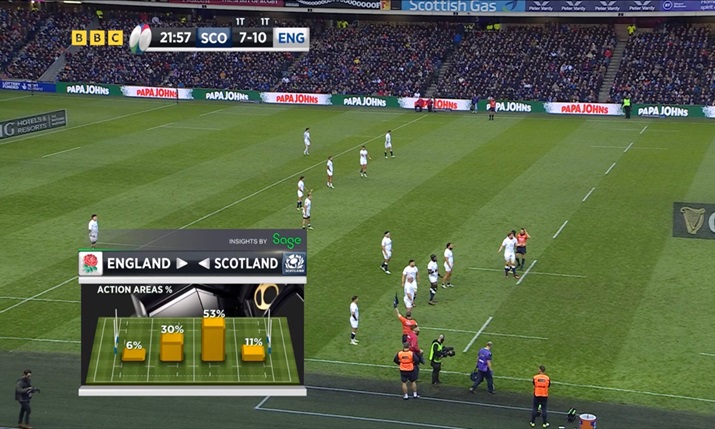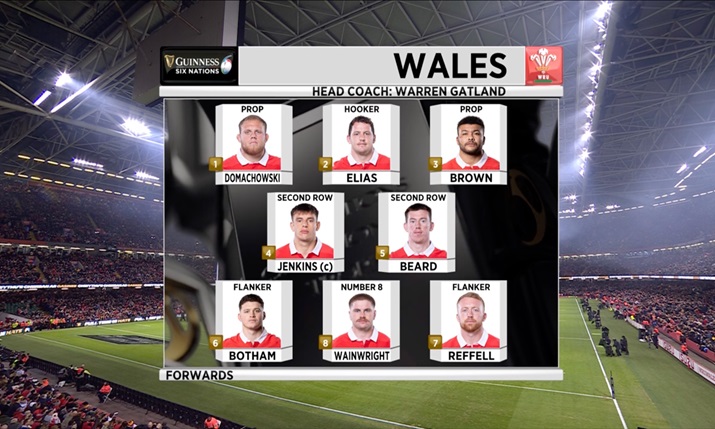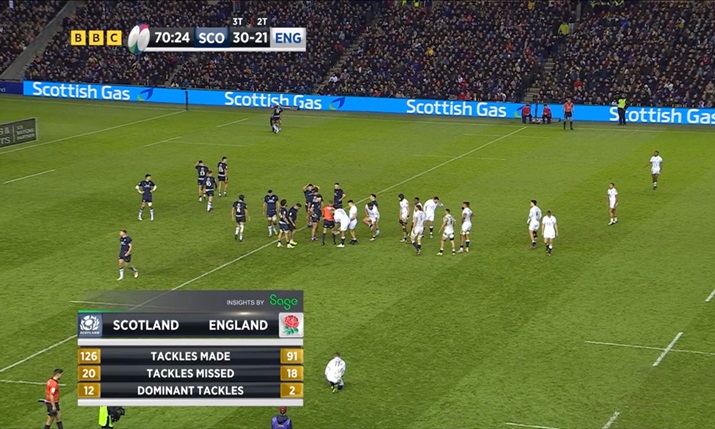Six Nations 2024: Complex graphics workflow simplifies story of the game

Action area stats illustrate a good opening 20 minutes for England with 64% of play in the Scotland half
With France thumping Wales, Italy stunning Scotland and England edging past Ireland thanks to a last-minute drop goal, the penultimate weekend of the Guinness Men’s Six Nations Championship was the usual blend of action and drama setting the stage for an exciting round of final matches on Saturday (16 March).
Graphic solutions provider AE Live has worked with Six Nations Rugby for many years and is currently in a contract that runs until 2025. AE Live produces the world feed graphics for the Men’s, Women’s and Under-20s Six Nations as well as the Autumn Nations and Summer Series. Along with the world feed the company provides any unbranded feeds as required (if, for example, the word ‘Guinness’ needs to be removed from the graphics output for certain territories).
AE Live also delivers multi-language graphics – in French, Italian and Welsh – at the same time as the world feed. And the graphics company also works with most of the broadcasters on their unilateral presentation of the competition, including BBC Sport, France TV, ITV Sport and S4C.
In terms of how the Six Nations graphics palette has grown, latest additions are the on-screen and in-venue shot clock, the bunker TMO foul play review process, and data from Sportable’s Smart Ball which is integrated into the match graphics by AE Live and out to air.
“At AE Live we use Vizrt as our foundation renderer, and we write all of our own software,” project manager James Smith told SVG Europe. “All the applications we use across Six Nations are written in-house, and we’ve used those for many years across lots of different broadcasters.

Wales team line-up for opening Six Nations match against Scotland on Saturday 3 February
“Those pieces of software provide a link between our tech department and our partners: Stats Perform, Sportable and Swiss Timing. This allows us to provide graphics at a rate that we can’t do in any other sport. It’s as good as it can possibly be on rugby, with about five or six pieces of software running at any time.
“AE Drive is our rugby output software that actually generates the graphics. We have our AE Catch data handling system – you can see where we’re going here with Catch and Drive – where the data comes in and we ‘catch’ it. Then there’s AE Tick, which controls the clocks which have now become an enormous part of the game.
“AE Snap, our CIS [Commentator Information System], is the tool that does an awful lot of work in pulling together the timing, scoring, Stats Perform and the Sportable Smart Ball data into one usable screen that is shared around the OB and is visible to everyone in production, commentary and graphics,” said Smith.
“And finally the one without the catchy title is our MQTT software, which stands for Message Queueing Telemetry Transport. We’ve only written that in the last two years or so, since we’ve been working more closely with Sportable. It allows us to lay out Sportable captions without having to touch them at all. The data comes straight from Sportable into our software; we are hands-off, and it animates on-screen.
“They provide two feeds on-site that we’re interested in: the first one that I talked about is the MQTT, our software that is pulling down what we would call Snap Stats. When the ball is kicked into touch, a little Sage-sponsored drop-down appears that says ’52 metres’. Distance to try-line, territory gain and longest pass are the other common ones you would see on-screen.
“That on-site data is transmitted via fibre and as soon as the ball lands it sends a trigger to our MQTT software that picks it up and animates it on-screen. Now we don’t put everything on screen so we have to ignore an awful lot of information. If it’s not adding editorial value it is dismissed by our software.
“The second feed they send is a regular API and we pick it up in the way we do for a Stats Perform file. We pull that down with our AE Catch software and it is more editorially led, so comparing one player’s number of passes with another for example – information that is collected over the course of the game. That allows the producers to pull out stories as the game unfolds.
“Six Nations is blessed with having a number of people across this, which is great. On-site there is a [Six Nations] world feed producer, a broadcast producer and a world feed graphics producer, as well as our graphics team. They are there specifically to look at these data sets and drive them into production. It is really helpful to have these people on-site, away from our ops who are doing the actual graphics, producing the show and picking up stories that we want to push.
“Another example this year is that France Télévisions have employed former France number eight Thomas Lievremont to sit with our graphics operator in the truck and push that data out. And it’s hard to ignore a six-foot five former professional rugby player in the truck, providing an extra incentive to put a graphic to air!”
Kicking shot clock set-up with Swiss Timing
With the bunker TMO and other innovations coming into rugby, it’s more imperative than ever that the entire production team is fully briefed going into each match each weekend on what is happening on the pitch, as rugby continues to become a more complex game and thus potentially a more confusing spectacle to watch. And, needless to say, the palette of on-screen TV graphics now plays a key role in making the unfolding match understandable to viewers at home, and in pubs and clubs.
“Yes very much so, and I think Six Nations are really good at this,” said Smith. “To share information and tell their story, they need everyone to be on the same page. They have a broadcaster meeting before every tournament to go through what’s in the general package, how the world feed running orders are going to go, but also any innovations and updates – which is really important.
“As well as the broadcaster meetings, Six Nations also holds individual rugby union meetings with the people who look after the stadiums. Decisions that impact the broadcast also impact the stadium. For example, this year Six Nations has moved to Swiss Timing to control its clock systems. And of course, that changes how clocks are being run in the stadium as well – and they are also producing the shot clock feed in the stadium.

Sage-sponsored stats for Scotland vs England on Saturday 24 February help to tell the story of the first 70 minutes
“So the six unions need to be part of that conversation, and Six Nations does all of that ahead of each tournament – and we play quite a role there in explaining our part as a technological partner. And on-site this year, we actually keep the Swiss Timing box and the official timekeeper in our AE Live van on-site next to our operator. We have oversight of that whole shot clock set-up, controlling it for the broadcast but also controlling it for the stadium as well, so the referee and kicker can see it on the big screens,” said Smith.
Despite all its commitments across world feed, branded and unbranded versions, unilateral presentations, different language feeds and the seemingly ever-increasing on-screen graphics real estate we see on Six Nations matches, the AE Live van at each stadium still contains just two members of staff.
Read more Six Nations 2024: Broadcast coverage to feature innovation in the bunker, on the pitch and online
Read more Six Nations 2024: ITV Sport powers ahead with on-site broadcast coverage
“We’re pleased to still only have two AE people on-site for the world feed element. We actually have a very small footprint and turn up on TX-1 for set-up. Our AE van houses all the equipment we need including Viz and our own software. These vans can house up to five people but we prefer not to have five people in there. And as mentioned we now have the official timekeepers in that truck as well, connected via talkback and visual to the referees.
“The small team on-site is supported by an enormous team here at AE, including our software and design team which is permanently on call to fix, change or update anything our partners may wish us to change over the weekend. And of course my project team is always available: we live and breathe the tournament for this seven weeks of the year. And our operations team has grown quite a bit recently as well, with training coordinators and managers often on-site to check everything is OK.
“It seems quite basic but we also have a number of WhatsApp groups with check-in points throughout match days, including external groups with Sportable and Stats Perform – just to share information really.
“The beauty of our software applications is that they simplify everything. The operators are still using the same interface yet there are now more buttons, more information, more to remember. So they do require support – far more than there ever has been off-site – allowing us to keep that small footprint on-site, which is really important nowadays,” said Smith.

